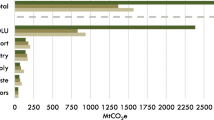Abstract
Cross-cutting government policies that are designed to mitigate CO2 emissions have caused an increased interdependence between government agencies. This leads to fragmentation in the public administration of climate change mitigation. The need for more coordination among government agencies involved in drafting and implementing energy and transportation policies is necessary to create collaborative strategies that can affect energy demand and reduce CO2 emissions. The study aims to use Thailand as a case study to examine and discuss how effective coordination and integration of energy and transport policies and actions in the domain of GHG mitigation in Thailand can be successful. The authors applied a mixed-method information gathering approach combined with data from panel discussions. A thorough literature review guided the evidence, which was reinforced by the expert opinions of 35 industry professionals and governmental officers. Importance-performance analysis was applied as a policy assessment method. The study proposes applying a combination of several factors and conditions regarding institutional aspects of transport and energy sectors into a new greater strategies and actions toward CO2 mitigation. In findings, a combination of instruments and autonomy of sectors is the greatest important and successful opportunity to enable effective coordination and integration of policies for CO2 mitigation. Insightful discussions on integrated approach and recommendations would contribute to collaboratively administrative mechanism.




Similar content being viewed by others
References
Agranoff, R. (1986). Intergovernmental management. Human services problem-solving in six metropolitan areas. State University of New York Press.
APEC (2010). Peer review on energy efficiency in Thailand, Report from the APEC energy working group.
Cutlip, L., & Fath, B. D. (2012). Relationship between carbon emissions and economic development: Case study of six countries. Environment, Development and Sustainability, 14, 433–453.
Gururaja, J. (2003). Energy for sustainable development: Review of national and international energy policies. Natural Resources Forum, 27(1), 53–67.
Hajer, M. (2006). Doing discourse analysis: Coalitions, practices, meaning. In M. van den Brink & T. Metze (Eds.), Words matter in policy and planning: Discourse theory and method in the social sciences, Netherlands Geographical Studies 344 (pp. 65–74). Utrecht: KNAG/Nethur.
Hinti, I. A., Ghandoor, A. A., Akash, B., & Abu-Nada, E. (2007). Energy saving and CO2 mitigation through restructuring Jordan’s transportation sector: The diesel passenger cars scenario. Energy Policy, 35, 5003–5011.
Hjorth, P., & Dan, N. T. (1994). Water management options for urban areas in Asia. Cities, 11(2), 125–130.
Ko, J., Cho, Y., Choi, J., & Kim, T. H. (2009). Evaluation of travel demand management strategies using importance-performance analysis, in transportation research record. Journal of the Transportation Research Board, 2118, TRB, National Research Council, Washington, D.C., pp. 67–74.
Li, W., & Chan, H. S. (2009). Clean air urban China: The case of inter-agency coordination in Chongqing’s blue sky program. Public Administration and Development, 29, 55–67.
Mateo, R. M. (1992). Administration of water resources: Institutional aspects and management modalities. Natural Resources Forum, 16(2), 117–125.
Meijers, E. & Stead, D. (2004). Policy integration: What does it means and how can be achieved? A multi-disciplinary review. Berlin conference on the human dimensions of global environmental change: Greening of policies interlinkages and policy integration.
Ostrom, E. (1990). Governing the commons: The evolution of institutions for collective action. Cambridge: Cambridge University Press.
Peter, B. G. (1998). Managing horizontal government: The policies of coordination. Public Administration, 76(2), 295–311.
Pipitsombat, N. (2012). Policy related to climate change in Thailand, Presentation from the Office of Climate Change Coordination, Office of Natural Resources and Environmental Policy and Planning, Ministry of Natural Resources and Environment, Thailand.
Stead, D. (2008). Institutional aspects of integrating transport, environment and health policies. Transport Policy, 15, 139–148.
Stead, D. & de Jong, M. (2006). Practical guidance on institutional arrangements for integrated policy and decision-making. United Nations Economic Commission for Europe and World Health Organization Regional Office for Europe Report ECE/AC.21/2006/ 7-EUR/06/THEPEPST/7. Geneva/Rome: UNECE/WHO-Europe
Warren, R. L., Rose, S. M., & Bergunder, A. F. (1974). The structure of urban reform. Lexington: Lexington books.
Author information
Authors and Affiliations
Corresponding author
Rights and permissions
About this article
Cite this article
Klinsrisuk, R., Nitivattananon, V. & Wongsurawat, W. Effective coordination and integration of energy and transport policies for CO2 mitigation in Thailand. Environ Dev Sustain 15, 1227–1244 (2013). https://doi.org/10.1007/s10668-013-9435-3
Received:
Accepted:
Published:
Issue Date:
DOI: https://doi.org/10.1007/s10668-013-9435-3




